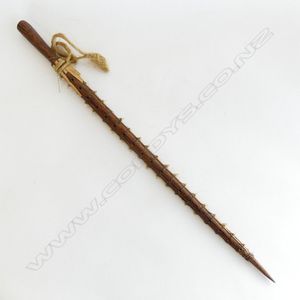
Kiribati Shark Tooth Sword on Palm Wood Shaft, 63cm Length
A Sharks tooth sword from Kiribati, teeth bound and mounted on palm wood shaft. Some losses, length 63 cm
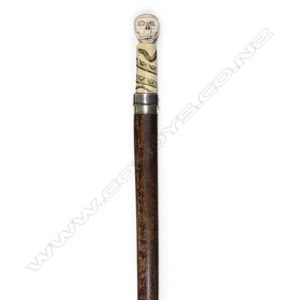
Marine Ivory Sword Walking Stick with Scrimshaw Handle
A 20th century marine ivory and scrimshaw handled sword walking stick, the handle with carved skull end and snake scrimshawed in colour to the grip section, and with metal fittings. The long spike blade of tapered rectangular section. The oak main shaft…

Toposa Sword and Turkana Walking Stick Set
Toposa sword with Turkana wooden walking stick, 145 cm x 80 cm

Black Enamelled Gilded Sword Stick, c.1900
A c.1900 black enamelled sword stick, With single edged fullered blade with spear point tip, gilded highlights towards the handle. Length 92 cm.

Beech Sword Stick Cane with Etched Blade
A sword stick cane, beech enclosing an etched single edged blade with turned beech handle. Length 95 cm
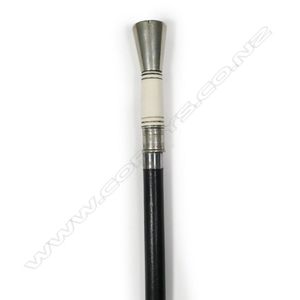
Black leather sword cane with chromed blade
A sword stick cane, black leather covered cane, with chromed blade, the bone handle with silver plated ferrule and pommel. Length 99 cm

18th Century Bamboo Walking Stick Sword with Ivory Handle
Bamboo walking stick sword likely 18th century, having an ivory handle carved in the form of a man's head with floppy cap and fitted with a horn collar. Having un- marked silver and brass finials. Blade not marked. Length 92.5 cm.

Concealed Sword Walking Sticks with Toledo Blade
Three novelty gentleman's walking sticks, late 19th/early 20th century, two with a concealed sword, one marked to the blade 'Toledo'. Together with a concealed pencil and a compartment for housing lead, above a writhen shaft, 105.5 cm high, 104 cm and 102…

Edwardian Walking Stick Sword with Silver Fittings
Walking stick sword an Edwardian walking stick with horn handle, wooden shaft and concealed short sword with makers marks on the blade unidentifiable. Complete with silver fittings. Length 89 cm

Edwardian Walking Stick Sword with Silver Fittings and Engraving
Walking stick sword an Edwardian gentlemen's rattan cane walking stick with silver fittings. Maker Henry Tracy & Sons London assayed 1921. Having engraving (Leb 1927). Blade showing stamps France 5.

Indo/Persian Sword Stick with Niello Decoration and Hidden Dagger
An Indo/Persian steel sword stick with niello decoration, the curved handle with animal head and traditional inlaid decoration, unscrews to reveal a dagger, tapering shaft. Length 95 cm.
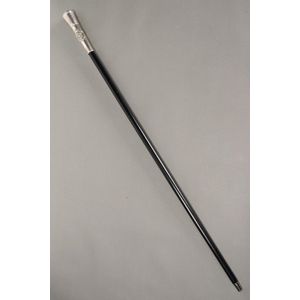
Russian Silver Sword Stick with St. George Image and Compass
Russian silver sword stick, the top set with an image of St.George and the dragon, opening to an inset compass, above a Russian coat of arms, twisting to reveal sword, above an ebonised cylindrical support, length 93.5 cm

Russian Sword Stick with Double-Headed Eagle Handle
Russian sword stick, with an angled handle, with Russian double headed eagle on tapering ebonised support, length 90 cm

Victorian Walking Stick Sword with Horn Handle and Silver Accents
Walking stick sword a very fine example of a mid-Victorian, style walking stick with hidden sword blade, polished horn handle, silver finial, cap and embellishments. Makers marks unidentifiable due to wear.
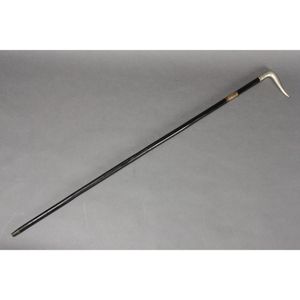
Curved Handle Cane Sword Stick
Late 19th century cane sword stick, with curved metal handle above ebonised case, with sword stick inside, length 94 cm

Horn-handled Sword Stick with Tapering Fullered Blade
A horn handled sword stick, with a long tapering fullered blade with flat back, length 91 cm

19th Century American Regulation Sword by Frank Selger & Son
A 19th century American Regulation staff & field officers sword, 1860 pattern. By Frank Selger & Son. Etched rapier style blade. Cast brass D. Knuckle guard with stands of arms. Leather wrapped wooden grip brass scabbard. Overallmm, length 90 cm
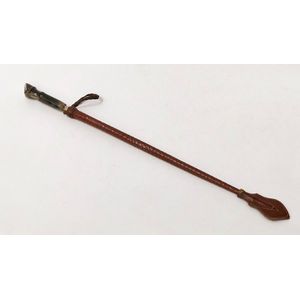
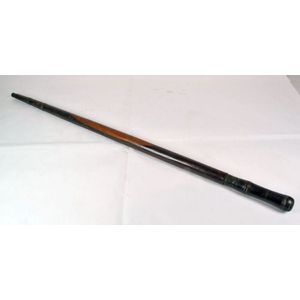

 Loading more...
Loading more...